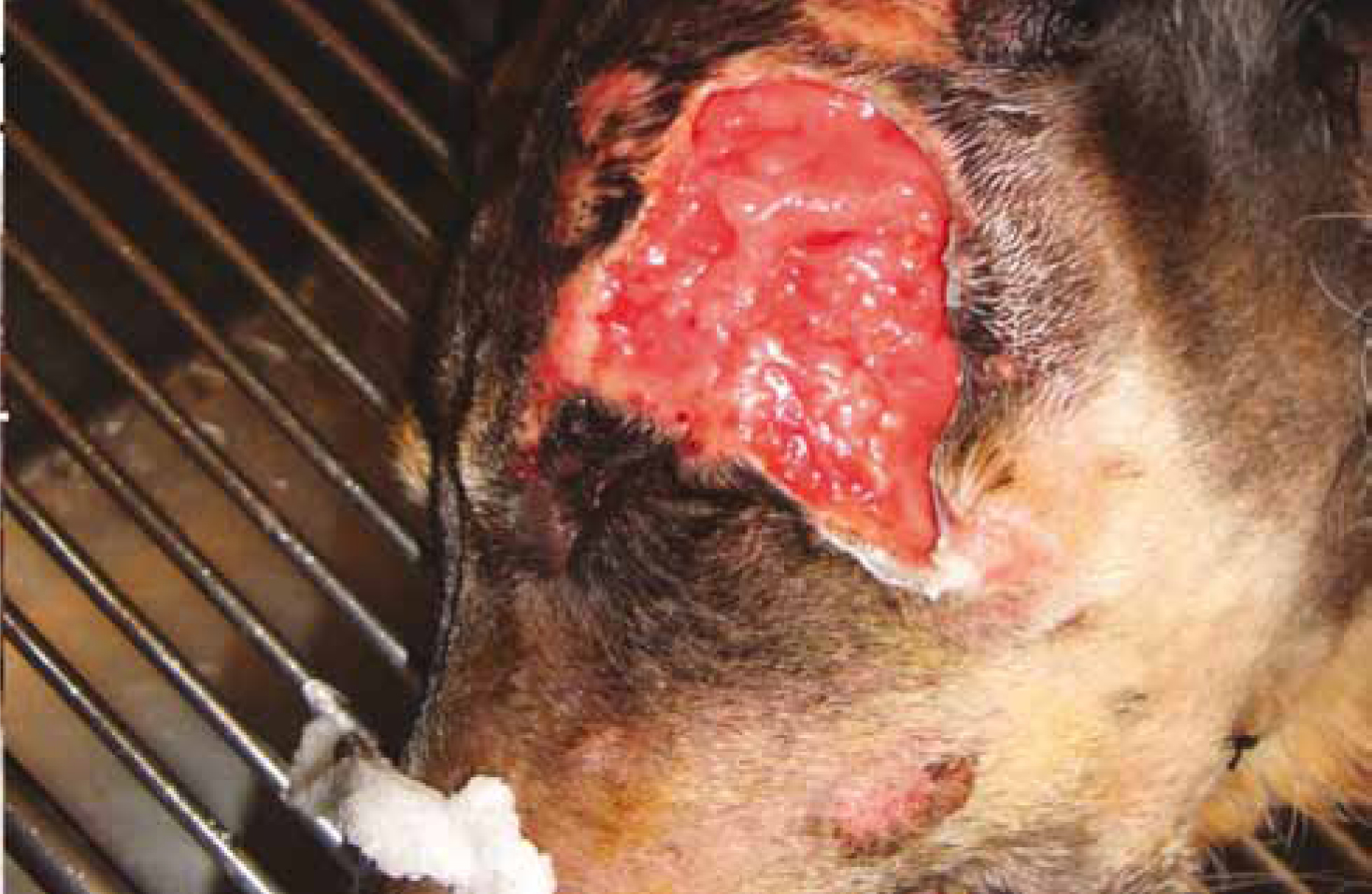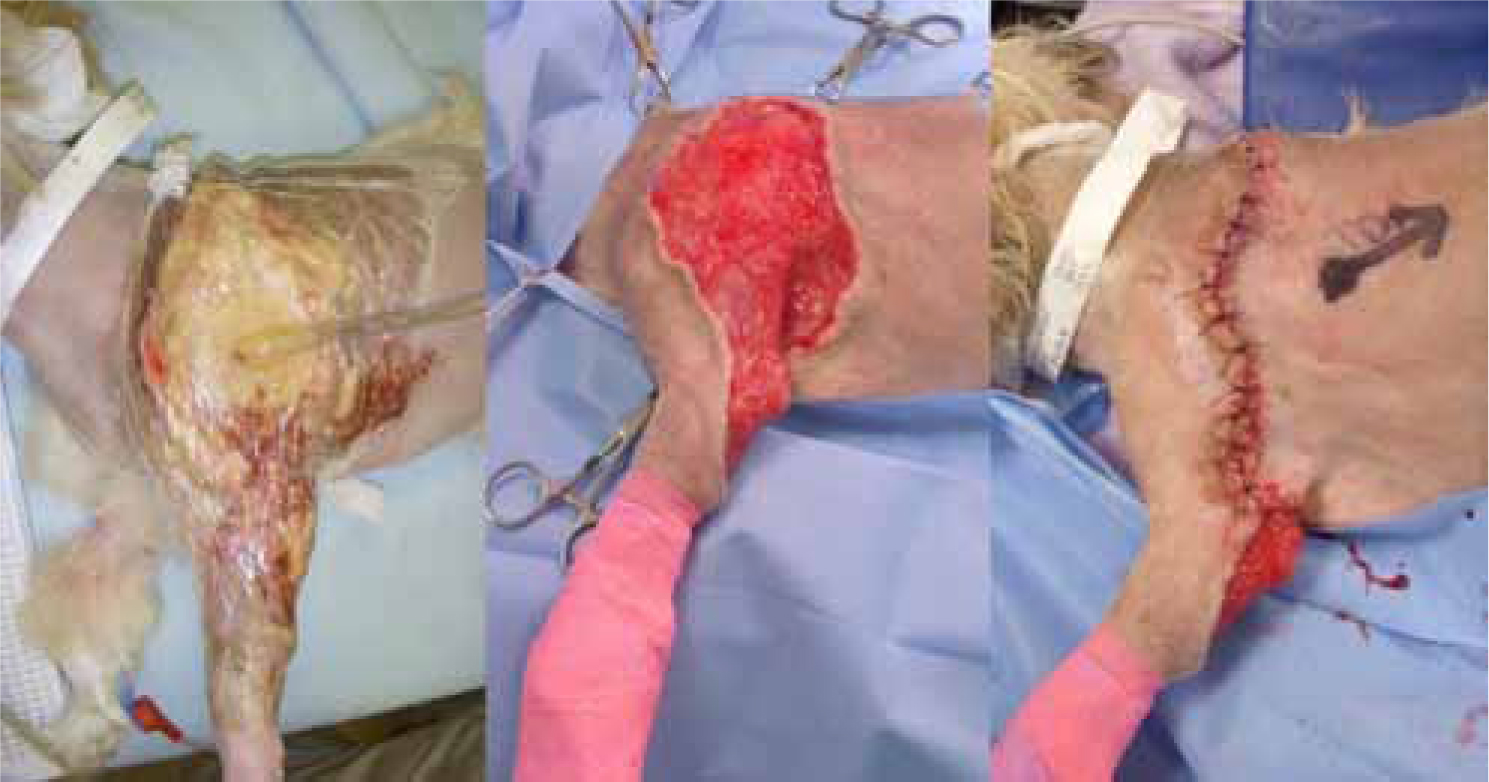Veterinary wound management has developed largely from human reconstruction and plastic surgery principles. The role of wound dressings being further extrapolated from human experience.
In the last two decades a range of technologies have developed for human use which have begun to show promise in the veterinary patient. Some of these may offer solutions for challenging cases and potential improvements in outcomes.
Aims of wound management
It is true that many wounds heal despite the management adopted. This may explain the persistence of many old fashioned and out dated products found on shelves in many clinics and cupboards in veterinary practice. Modern methods focus on preservation of healthy tissue while maintaining cellular function. The most advanced methods to date are based on removing the barriers of optimal healing while maintaining a moist wound environment for cellular proliferation (Enoch and Harding, 2003).
In terms of decision making when faced with wounds the following three statements should be true:
- The management plan should provide the patient with a functional, cosmetic repair so that the animal can function normally and the deficit and healing process does not impact the function of local structures (Figure 1)
- The methods adopted should minimise pain and distress and unnecessary risks. This includes avoiding unnecessary anaesthesia, prolonged management and interventions where the stress may outweigh the benefit of management
- Finally, the intervention should enable the patient to be back to normal use as quickly as possible. This is a common issue where there are large limb wounds and limited budgets. Bandaging may be considered the cheaper alternative to surgery, but may take considerably longer.

Technologies for improving healing: what to use when?
Technologies for wound healing are designed to make life easier for both the clinician and the patient while optimising the healing process.
Based on the objectives and principles of wound bed preparation and optimal healing Georgie Hollis has begun to categorise management of wounds into three clinical objectives. Prepare, Promote and Protect. By using this system it becomes easier to identify which of the newer technologies offer benefits and at which stages of management.
Prepare
Wound bed preparation is without doubt the most important step in wound management and is largely within the remit of the veterinary nurse. Important steps include use of hydrogel in the wound prior to clipping to prevent added contamination of hair and debris, followed by thorough lavage at pressure (8–15 psi), being best practice and critical in reducing contamination and bioburden. Data presented by Owens and Wenke (2007) demonstrated that timing of wound lavage can be influential. Their data state that for every hour earlier a wound is lavaged the rate of bacterial proliferation will be reduced by half. This illustrates the benefit of early lavage in reducing infection risk and may be good advice for owners who may be able to wash wounds immediately after injury if it is safe to do so.
Lavage should be followed by thorough inspection of the wound taking into account the history and any potential complications. These can be listed and addressed according to the 12 factors of healing delay (Box 1).
Box 1.12 factors of healing delay
- Necrotic tissue
- Foreign body
- Infection/infestation
- Movement
- Altered local pH
- Paucity of blood supply
- Paucity of oxygen supply
- Poor nutritional and health status
- Local factors
- Iatrogenic factors
- Genetic factors
- Cell transformation
(Kottenbelt, 2007)
An area of intense research focuses on the development of bacterial biofilms in wounds. These biofilm colonies of bacteria are difficult to remove using normal lavage methods and can shield themselves with a protein coat that is impenetrable to antiseptics and antibiotics. They are most commonly blamed for failure and dehiscence associated with orthopaedic implants where colonies reside on the inert surface of bionic materials. Products that aim to reduce the risk of biofilm formation include lavage solutions such as those containing non-cytotoxic antiseptics. These include compounds such as polyhexamine biguanide (PHMB), octenidine dihydrochloride and dialkyl carbamoyl chloride (DACC), among many others.
Wound dressings may also capitalise on new antimicrobial technologies combining ingredients that offer novel ways to reduce bioburden while combining debridement and moist wound management properties. Common examples includes ionic dressings (e.g. silver, carbon or DACC) with positively charged molecules which combine with negatively charged pathogens to disable them, and the popular use of manuka honey which aids debridement through osmosis and provides a broad spectrum antimicrobial effect derived from plant and honey enzymes.
Whatever method of cleansing is chosen it does not substitute for proper debridement. and short cuts during this stage inevitably reduce the wound's ability to proliferate and produce healthy granulation tissue.
Promote
Once debridement is achieved the clinical aim is to promote the formation of healthy granulation tissue. This means maintaining a moist environment through selection of dressings that can either absorb excess exudate such as foams, alginates and polyacrylate pads, or through the use of products that are able to donate moisture to wounds, but that may dry between dressing changes. These include hydrogels and hydrocolloids. Manuka honey is commonly used to achieve a moist bacteria free environment in wounds, however it is not recommended once granulation tissue has formed as the high sugar, acidic environment can contribute to exuberant granulation tissue formation. In any case, the antimicrobial and debridement benefits of manuka honey are unwarranted during the proliferative phase of healing.
Some newer products for promoting healthy granulation tissue includes collagen and hyaluronic acid. They are not new in principle with examples having been used for corneal injuries for many years. (e.g. Vet Biocist®, Smiths Medical; and Remend® Eye Gel, Bayer). The role of these products is to provide structure for remodelling of the wound bed while providing a resource for fibroblast activity. The structure and substrates themselves reawaken the role of the fibroblast in both remodelling the wound bed and stimulating wound contraction. The use of these products is not currently routine but offer a logical and sympathetic concept to support granulation tissue formation when combined with the benefits of moist wound healing.
Finally, in terms of promoting healthy granulation tissue formation the use of negative pressure wound therapy (NPWT) must be mentioned. The development of NPWT has literally revolutionised the management of many open wounds in human healthcare reducing the need for interventions, improving quality of life for patients and markedly reducing healing times. The device is an alternative to the use of wet-todry dressings and moist wound healing in preparation for proliferation and formation of a healthy granulating wound bed. NPWT involves sealing the wound using film dressings or adhesive drapes through which a suction tube is placed (Figure 2). A porous or gauze dressing will be used to fill the deficit and allows passage of exudate from the wound bed through the tube. The tube is attached to a vacuum that provides continuous or pulsed suction at a rate of up to 120 mmHg to create a negative pressure within the wound site. Exudate is drawn through the wound, up the tube and into a disposal canister and the wound bed itself becomes vascularised more quickly as granulation is drawn up into the wound. The device is relatively comfortable and patients are able to eat, sleep and exercise gently. The biggest challenge appears to be maintaining a seal around the wound site to ensure the vacuum is effective. A considerable number of cases have been documented over the last decade by Dr Bryden Stanley and colleagues from Michigan State University. Their experience demonstrates a value in the role of NPWT in not only encouraging rapid granulation tissue formation allowing earlier wound closure, but demonstrates further applications in the surgical reconstruction (Stanley, 2013). Although costs may be higher than traditional wound management there appears to be a benefit in terms of reduced dressing changes and a reduction in total anaesthesia events required for closure.

Protect
The importance of wound protection is clear to most who deal with animals. Bandaging, immobilisation and dressing the wounds are part and parcel of preventing trauma at the wound. Clearly not every client can be persuaded to comply, but by limiting and identifying the factors that delay healing early in the management will ensure that the patient has the best chance of recovery within the aims of wound management (Box 1).
Conclusion
It is tempting to try new ideas that may have credible human case reports to show positive outcomes, but always consider the application in terms of impact on healing aims. If a wound is failing to heal consider what needs to be overcome. If tissue deficit is the issue there is still no product that can replace the benefit of real skin and skilled reconstruction.
The Wound care workshop was kindly sponsored by Bayer.


